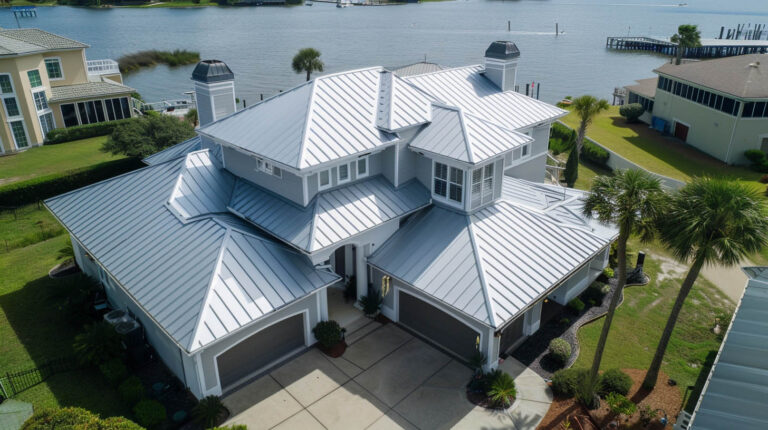
Blog
The 7 Most Common Causes of Roof Leaks
Roof leaks can cause significant damage to your home, leading to mold growth, rotting wood, and even structural problems if left unaddressed. Identifying the source of a leak early can save you from costly repairs. Here, we’ll discuss the seven most common causes of roof leaks, giving you insight into what to look for when inspecting your roof. If you’re a homeowner in Jacksonville, FL, and notice any of these issues, Avenue Roofing can help protect your roof from further damage.

1. Broken or Missing Shingles
Shingles serve as the first line of defense for your roof. Over time, weather conditions such as strong winds and heavy rains can cause them to crack, curl, or even break away, leaving exposed areas vulnerable to leaks. Damaged shingles are easy to spot—look for missing pieces or cracks when inspecting your roof.
Additionally, after a storm, check the ground around your home for shingle pieces, which could indicate your roof needs immediate attention.
2. Cracked or Damaged Flashing
Roof flashing is the thin metal material installed to direct water away from roof joints, chimneys, vents, and skylights. Over time, flashing can corrode or crack, leading to leaks around these critical areas. Inspect the flashing for signs of rust or cracks. If the flashing has deteriorated, it can no longer prevent water infiltration, and replacing it is essential to avoid leaks.
3. Clogged Gutters
When gutters become clogged with leaves, twigs, and debris, they can no longer channel water away from your roof. Instead, water builds up and seeps into your roof, causing leaks. Regularly cleaning your gutters and downspouts, especially before the rainy season, can prevent this issue. Check for water pooling around your roof and ensure that your gutters are clear to avoid leaks caused by water backup.
Unique Fact: According to the National Association of Home Builders (NAHB), clogged gutters are responsible for up to 75% of roof-related water damage cases. Regular gutter maintenance is key to preventing leaks.
4. Aging Roof
As your roof ages, the materials naturally deteriorate, making it more susceptible to leaks. The average lifespan of an asphalt shingle roof is 20-30 years, while other materials like metal or tile may last longer. If your roof is approaching the end of its life expectancy, leaks are more likely to occur. Inspect your roof for signs of aging, such as curling shingles, granule loss, or fading, and consider a replacement before leaks become frequent.
5. Cracked Chimney
Chimneys are one of the most vulnerable parts of a roof when it comes to water damage. If the mortar or flashing around the chimney becomes cracked or deteriorated, water can easily seep into your home. Check for cracks along the chimney’s mortar joints, the mud cap, and around the flashing. Addressing these issues promptly can prevent significant water damage to your roof and interior.
6. Condensation in the Attic
Condensation in your attic can lead to moisture buildup, which eventually results in mold, mildew, and roof leaks. This typically occurs when the temperature inside your attic differs significantly from the temperature outside. The trapped moisture can damage your roof over time. If you notice a musty odor, mold growth, or damp insulation in your attic, inadequate ventilation is likely the cause. Improving your attic’s ventilation can help prevent condensation and protect your roof.
7. Skylight Leaks
Skylights are beautiful additions to any home, but if improperly installed or aging, they can become a source of leaks. Water can seep around the edges of the skylight or through cracks in the glass. If you notice water stains or dripping around your skylight, the issue may be due to faulty flashing or seals. Minor leaks can often be fixed with silicone sealant, but for more significant problems, it’s best to consult a professional roofer.
FAQs
1. How can I tell if my roof is leaking?
Signs of a roof leak include water stains on your ceiling, damp insulation in your attic, or mold growth. Inspect your roof for missing or cracked shingles, damaged flashing, and clogged gutters.
2. How often should I inspect my roof for leaks?
You should inspect your roof at least twice a year—once in the spring and once in the fall. Additionally, inspect your roof after major storms or high winds.
3. Can I fix a roof leak myself?
Minor leaks caused by clogged gutters or missing shingles can sometimes be fixed by homeowners. However, for more complex issues like damaged flashing or cracked chimneys, it’s best to consult a professional roofer.
4. How much does it cost to repair a roof leak?
The cost of repairing a roof leak depends on the extent of the damage. Minor repairs may cost between $150 and $400, while more severe leaks requiring flashing or chimney repairs can cost upwards of $1,000.
5. Can a leaking roof lead to more serious problems?
Yes, a roof leak can lead to mold growth, wood rot, and even structural damage if left untreated. It’s essential to address leaks as soon as they’re detected to prevent costly repairs in the future.
Conclusion
Roof leaks can range from minor annoyances to major issues that compromise the safety of your home. By understanding the most common causes of leaks and performing regular inspections, you can catch problems early and prevent extensive damage. Whether it’s broken shingles, clogged gutters, or aging materials, addressing the source of the leak promptly is key to maintaining the longevity of your roof.For tips on hurricane preparedness and how to protect your roof before the storm hits, click here.



